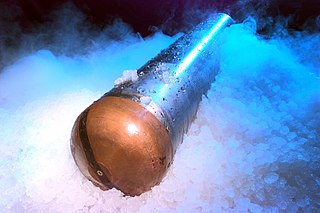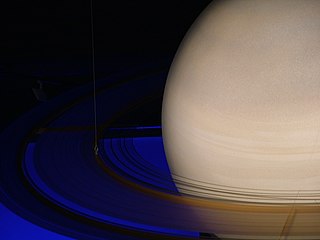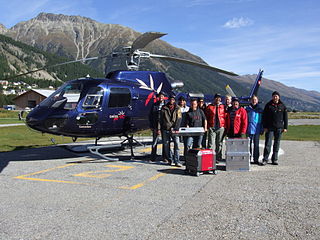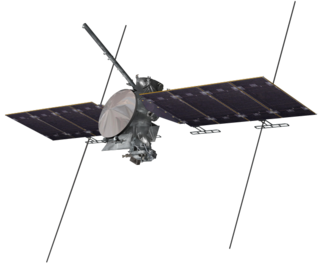
Astrobiology, formerly known as exobiology, is an interdisciplinary scientific field that studies the origins, early evolution, distribution, and future of life in the universe. Astrobiology considers the question of whether extraterrestrial life exists, and if it does, how humans can detect it.

Europa, or Jupiter II, is the smallest of the four Galilean moons orbiting Jupiter, and the sixth-closest to the planet of all the 80 known moons of Jupiter. It is also the sixth-largest moon in the Solar System. Europa was discovered in 1610 by Galileo Galilei and was named after Europa, the Phoenician mother of King Minos of Crete and lover of Zeus.

A lander is a spacecraft that descends towards, comes to rest on, the surface of an astronomical body. In contrast to an impact probe, which makes a hard landing that damages or destroys the probe upon reaching the surface, a lander makes a soft landing after which the probe remains functional.

Enceladus is the sixth-largest moon of Saturn. It is about 500 kilometers (310 mi) in diameter, about a tenth of that of Saturn's largest moon, Titan. Enceladus is mostly covered by fresh, clean ice, making it one of the most reflective bodies of the Solar System. Consequently, its surface temperature at noon only reaches −198 °C (−324 °F), far colder than a light-absorbing body would be. Despite its small size, Enceladus has a wide range of surface features, ranging from old, heavily cratered regions to young, tectonically deformed terrains.

The Astrobiology Field Laboratory (AFL) was a proposed NASA unmanned spacecraft that would have conducted a robotic search for life on Mars. This proposed mission, which was not funded, would have landed a rover on Mars in 2016 and explore a site for habitat. Examples of such sites are an active or extinct hydrothermal deposit, a dry lake or a specific polar site.

A cryobot or Philberth-probe is a robot that can penetrate water ice. A cryobot uses heat to melt the ice, and gravity to sink downward.

The Deep Phreatic Thermal Explorer (DEPTHX) is an autonomous underwater vehicle designed and built by Stone Aerospace, an aerospace engineering firm based in Austin, Texas. It was designed to autonomously explore and map underwater sinkholes in northern Mexico, as well as collect water and wall core samples. The DEPTHX vehicle was the first of three vehicles to be built by Stone Aerospace which were funded by NASA with the goal of developing technology that can explore the oceans of Jupiter's moon Europa to look for extraterrestrial life.

An ocean world, ocean planet, water world, aquaplanet, or panthalassic planet, is a type of terrestrial planet that contains a substantial amount of water as hydrosphere on its surface or as a subsurface ocean. The term ocean world is also used sometimes for astronomical bodies with an ocean composed of a different fluid or thalassogen, such as lava, ammonia or hydrocarbons like on Titan's surface.

The exploration of Saturn has been solely performed by crewless probes. Three missions were flybys, which formed an extended foundation of knowledge about the system. The Cassini–Huygens spacecraft, launched in 1997, was in orbit from 2004 to 2017.
ENDURANCE is an autonomous underwater vehicle designed to map in three dimensions the geochemistry and biology of underwater terrains in Antarctica. The vehicle was built and designed by Stone Aerospace, and is the second incarnation of the DEPTHX vehicle, which was significantly reconfigured for the challenges particular to the Antarctic environment.

Astrobiology Science and Technology for Exploring Planets (ASTEP) is a program established by NASA to sponsor research projects that advance the technology and techniques used in planetary exploration. The objective is to enable the study of astrobiology and to aid the planning of extraterrestrial exploration missions while prioritizing science, technology, and field campaigns.
Interplanetary contamination refers to biological contamination of a planetary body by a space probe or spacecraft, either deliberate or unintentional.
Stone Aerospace is an aerospace engineering firm founded by engineer and explorer Bill Stone, located in Del Valle, a suburb of Austin, Texas.

IceMole is an autonomous ice research probe, incorporating a new type of ice-melting tip for the exploration of polar regions, glaciers, ice sheets, and extraterrestrial regions, developed by a team from the FH Aachen, a Fachhochschule in Aachen, Germany. The advantage over previous probes is that the IceMole can change its direction and can be recovered after being used. A driving ice screw allows the probe to drill through soil layers and other contaminations in the ice.

Europa Clipper is an interplanetary mission in development by NASA comprising an orbiter. Planned for launch in October 2024, the spacecraft is being developed to study the Galilean moon Europa through a series of flybys while in orbit around Jupiter.

Enceladus Life Finder (ELF) is a proposed astrobiology mission concept for a NASA spacecraft intended to assess the habitability of the internal aquatic ocean of Enceladus, which is Saturn's sixth-largest moon and seemingly similar in chemical makeup to comets. The spaceprobe would orbit Saturn and fly through Enceladus's geyser-like plumes multiple times. It would be powered by energy supplied from solar panels on the spacecraft.
Life Investigation For Enceladus (LIFE) was a proposed astrobiology mission concept that would capture icy particles from Saturn's moon Enceladus and return them to Earth, where they could be studied in detail for signs of life such as biomolecules.
Enceladus Explorer (EnEx) is a planned interplanetary orbiter and lander mission equipped with a subsurface maneuverable ice melting probe suitable to assess the existence of life on Saturn's moon Enceladus.
The MAss SPectrometer for Planetary EXploration (MASPEX) is a mass spectrometer capable of high-resolution and high-sensitivity that allows the determination of a wide variety of chemical compounds in complex mixtures. This instrument will fly on board the planned Europa Clipper orbiter to explore Jupiter's moon Europa. This astrobiology mission will analyse the composition of Europa's surface while in orbit, and will directly assess its internal ocean habitability by flying through Europa's tenuous atmosphere.

BRUIE is an autonomous underwater vehicle prototype by NASA's Jet Propulsion Laboratory. The prototype began underwater testing in 2012 and it is meant to eventually explore the interior of water worlds in the Solar System, such as Europa or Enceladus.














